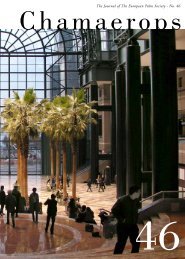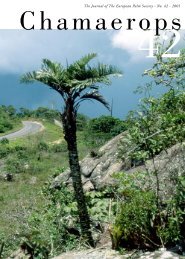Download - The European Palm Society
Download - The European Palm Society
Download - The European Palm Society
Create successful ePaper yourself
Turn your PDF publications into a flip-book with our unique Google optimized e-Paper software.
<strong>The</strong> Cretan Date <strong>Palm</strong>by Thomas Boeuf, Hauptstr. 6, 63796 Kahl am Main, GermanyCrete has a very special kind of beauty dueto its many different types of landscapes: highmountains, deep gorges, deserted caverns, fertilesoil, and rugged coasts. Crete's vegetation is veryrich, and the climate is mild. Situated at thecrossroads of Europe, Asia, and Africa, this islandis influenced by all these cultures. From Europeit got its cosmopolitan flair, from Asia itstradition, and from Africa the Sirocco…and thepalms!In relation to the size of the island, the usableland is comparatively small. Despite this, manytypes of fruits, vegetables, and spices grow. Deepin the gorges of Crete rare varieties of fauna andflora exist, many of which can only be found onCrete. <strong>The</strong> most important species, Phoenixtheophrastii, was named by the Swiss botanistWerner Greuter in 1938, for the Greek scholar<strong>The</strong>ophrast (371-287 bc.), who is said to be thefounder of botanical science.It is said that after the successful conquest ofthe island in 825, the Sarabene Abu Hafis Omarlanded on the beach of Vai, situated on the EastCoast of Crete. Following Arab tradition, theyate dates and spat out the stones on the beach.Since the time this took place, a grove of palmshas grown up and has given this spot a romanticaura. In reality these date palms belong to aspecies that exclusively grows on Crete and a fewspots on the southern coast of Turkey. Althoughclosely related to the true date palm, Phoenixdactylifera, its fruits are small and not reallyedible. <strong>The</strong>y might be relicts from the tertiaryand much older than the legend of Abu HafisOmar. Nowadays the beach of Vai is a nationalpark and is open to the public only in high seasonand other special times.When I was flying to Crete with Friends in< Trachycarpus fortunei (see previous page)October, I had in my mind a trip to the palmbeach of Vai to write an article for Chamaerops.Some years before I had been to Vai, andaccording to the guide, there were some otherplaces with palms growing in the wild. So, Ithought about finding these and other unknownplaces, especially as the eastern cape of Crete isdescribed in many books as the only place wherePhoenix theophrastii grow in the wild.After innumerable inquiries, I was given atip by an old Greek fisherman. One of the fewrivers of Crete flows into the Libyan Sea. <strong>The</strong>fisherman told me that this place is not easy toreach, and therefore only a few tourists are ableto visit it from seaside. This fact raised myinterest. <strong>The</strong> next day we rented a car and startedthe search. After several kilometers on unsurfacedroads, the giant mountains gave way toa sight of a frugal riverbed of incredible beauty.A few moments later we recognized the glitteringof the Libyan Sea. We parked our car and walkedto the seafront. From there the canyon couldnot yet be seen, but the groups of palms whichgrew close together along the river could. Fromthis place, a dangerous path went down the cliffin serpentines and we needed almost an hour toreach the canyon. A few people who seemed tohave reached the beach with fishing boats lay inthe sun and enjoyed the silence of the desertedbeach. I began my exploration.My first impression of this canyon was of anoasis in the hills of the Sinai peninsular. Withina range of 30m on both sides of the slowly flowingriver were all sizes and forms of Phoenixtheophrastii. Some were low and bushy, somehad tall or bent trunks. At some places, the palmsgrew in such a close and tight way that it was...continued on page 14page 7










